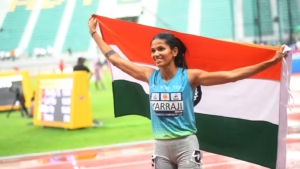In the churn of the ATP Challenger Tour, where raw potential meets hardened experience every single week, Aryan Shah’s three-set loss to Marc Polmans in Brisbane will feel like a gut punch.
Not because he was outclassed far from it but because he had the match in his hands before it slipped away in a way only tennis can script: slowly, point by point, and then suddenly, all at once. Shah came into this Australian swing with questions hovering over his form. For months, he had been hailed as the next big thing in Indian tennis, and not without reason. His level in the Spain Challengers earlier in the season was electric. His ball-striking, confidence, and physicality announced a player ready to climb, maybe even surge.
But the US tour that followed turned patchy. Shah won only two matches across four tournaments not disastrous, but nowhere close to the momentum he wanted to carry. And by the time he arrived in Brisbane, he was looking not just for wins, but for a sense of self again.
Read Articles Without Ads On Your IndiaSportsHub App. Download Now And Stay Updated
The first set was Shah at his assertive best: early hitting, disciplined patterns, excellent shot choices, and a willingness to step inside the baseline. Polmans, who came into the match in strong form after winning M25 Brisbane and making a final in the last few weeks, looked unsettled by the pace and depth coming off Shah’s racquet. The Indian teenager led the rallies, controlled rhythm, and showed exactly why he has been touted as a long-term Top-200 prospect.

The second set was more complicated. Shah was still creating chances, still absorbing Polmans’ big forehand and aggressive net-rushing with clarity. And when he reached match point, everything seemed aligned for a breakthrough win one that could have reset his entire narrative. But Polmans chose that moment to pull off a brilliant passing shot, the kind of instinctive, fearless strike only a seasoned Challenger competitor can thread under pressure.
Read Articles Without Ads On Your IndiaSportsHub App. Download Now And Stay Updated
Shah lost that set in a tiebreak, and by the start of the third, the physical and mental cost of the conditions began to show. Brisbane’s sun is unforgiving, and Shah forced to play the entire match squinting, repeatedly asking organisers for sunglasses that never came was visibly struggling. Underarm serves became a last-ditch adaptation rather than a tactic. Early in the third set, he had break chances but couldn’t convert. Once Polmans held firm, Shah’s energy dipped, his footwork slowed, and the match spiraled. The scoreline 1–6 in the third won’t reflect how evenly balanced the first 90 minutes were.
These are the kinds of weeks that shape Challenger players: the heat, the travel, the lack of resources, the mental grind, and the reality that you can play well and still walk away empty-handed. For Shah, who is still learning how to manage sharp swings in energy and momentum, this will be a reference point. A painful one, yes but also a useful one.
The good thing is that the tour always gives another chance. Next up is the Playford Challenger, another fast court where his first-strike tennis should translate well. What Shah needs now is not a miracle shift in form, but simply one solid win something to anchor confidence and flush out the frustration of a few shaky weeks.
The Broader Indian Picture: Karan Singh and the Struggles in Brisbane
It wasn’t just Shah who ran into difficulty in Brisbane. Karan Singh’s early exit against Marek Gengel continued what has quietly become a worrying stretch. Singh has been battling inconsistency since his strong runs in Monastir and at the Astana Challenger. After peaking around that time, the last few months have seen him win only four of his last twelve matches.
Against Gengel ATP 327, strong serve, heavy forehand, but shaky backhand Singh actually started well. He created break points in both of the Czech player’s early service games, even reaching 15–40 twice, but didn’t convert any of them. That failure to capitalize tilted him mentally, and once his frustration set in, Gengel’s cleaner baseline control took over. Long rallies increasingly favoured the Czech player, exposing Singh’s footwork and rally tolerance two areas that still need refinement at this level.
Still, Singh has time to reset before heading to the Sydney Challenger, where conditions will be slower and more favourable for his counterpunching patterns. Indian tennis fans will understandably feel a sense of disappointment after these Brisbane results. Shah had a real chance for a breakout win, and Singh had opportunities he let slip. But both players are in developmental phases of their careers it is the week-to-week adjustments, not the headlines, that will shape where they land a year from now.
For Shah, the important takeaway is simple: he belonged on that court. He outplayed a high-confidence opponent for significant stretches. He created match point. He handled the pace. He competed. And the conditions sun glare, fatigue, frustration won’t always be this unforgiving.
If anything, the match reinforced his ceiling rather than questioning it. He’ll grow from this. He has to. The tour demands it, and Shah has shown enough to believe he will.
Next stop: Playford. Another chance. A clean slate. And, hopefully this time, sunglasses.
How useful was this post?
Click on a star to rate it!
Average rating 5 / 5. Vote count: 2
No votes so far! Be the first to rate this post.






